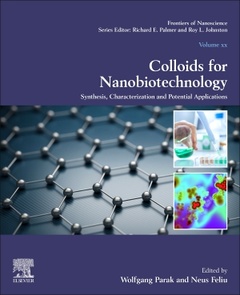Description
Colloids for Nanobiotechnology
Synthesis, Characterization and Potential Applications
Frontiers of Nanoscience Series
Coordinators: Parak Wolfgang, Feliu Neus
Language: English
Subject for Colloids for Nanobiotechnology:
Keywords
Autoimmune disease; Autophagy; Biodistribution; Biotechnology; Black phosphorus nanosheets; Cancer; Cancer immunotherapy; Cancer therapy; Carbon dots; Carbon nanoparticles; Characterization; Clinical translation; Computed tomography; Contrast agents; DNA; Drug delivery; Drug development; Drug encapsulation; Energy transfer assay; Ferroptosis; Fluorescence lifetime; Fluorescence spectroscopy; Förster resonance energy transfer; FRET; Gold nanoparticles; Gold nanorods; Graphene oxide; Immune system; Immunoassay; Immunotherapy; Macrophages; Magnetic particle imaging; Magnetic resonance imaging; Metal nanoparticles; Molybdenum disulfide nanosheets; Multimodal imaging; Nanobiology; Nanobiotechnology; Nanoimmunooncologicals; Nanoimmunotherapies; Nanomaterials; Nanomedicine; Nanoparticle; Nanoparticle applications; Nanoparticle characterization; Nanoparticle formulation; Nanoparticles; Nanosafety; Nanostructures; Nanotechnology; Nanotoxicology; Nucleic acids; Optical imaging; Palladium nanosheets; Pharmacokinetics; Photoacoustic imaging; Photodynamic therapy; Photothermal therapy; Plasmonic photothermal therapy; Plasmonics; Polymeric nanoparticles; Polymers; Positron emission tomography; Potential applications; Quantum dots; Radiotherapy; Ratiometric optical imaging; Reactive oxygen species (ROS); RNA; Semiconducting quantum dots; Sensing; SERS spectroscopy; Silica nanoparticles; Single photon emission computed tomography; Smart drug delivery systems; Sonodynamic therapy; Synthesis; Targeted delivery; Targeted hyperthermia; Toxicity; Twodimensional nanomaterials; Ultrasound imaging; Upconversion
398 p. · 19x23.3 cm · Paperback
Description
/li>Contents
/li>Readership
/li>Biography
/li>Comment
/li>
Colloids for Nanobiotechnology: Synthesis, Characterization and Potential Applications, Volume 17, offers a range of perspectives on emerging nano-inspired colloidal applications. With an emphasis on biomedical and environmental opportunities and challenges, the book outlines how nanotechnology is being used to increase the uses and impact of colloid science. Nanotechnology offers new horizons for colloidal research and synthesis routes that allow for the production of highly reproducible and defined materials. This book presents new characterization methods and a fundamental understanding of basic physicochemical, physical and chemical properties.
1. Colloids for Nanobiotechnology - An Introductio2. Surface-enhanced Raman scattering (SERS) sensing of nucleic acids3. Energy transfer with nanoparticles for in vitro diagnostic4. Nanoparticles for imaging application5. Colloidal nanoparticles as pharmaceutical agent6. Fluorescent nanoparticles for sensin7. Two-dimensional nanoparticles for the delivery of anticancer drugs and cancer therapy8. Engineered polymeric nanovehicles for drug deliver9. Polymer-based nanoparticles for biomedical applications10. Targeted delivery of nanoparticles11. Nanoparticles for immunotherap12. Targeted hyperthermia with plasmonic nanoparticles13. Current challenges and coming opportunities in nanoparticle risk assessment
Researchers in materials science, colloid chemistry and biomedicine
Neus Feliu is a Research Fellow at the Department of Physics and Chemistry at Hamburg University, Germany, and the Department of Laboratory Medicine (LABMED), Karolinska Institutet, Sweden. Her research is focused on engineered nanomaterials for biomedical applications.
- Explores the use of nanotechnology in enhancing colloidal characterization techniques
- Explains how colloids are being used in a range of nanomedical applications
- Demonstrates how nanotechnology is being used to create more efficient colloidal synthesis techniques




